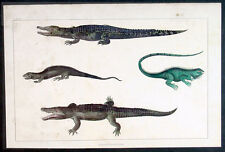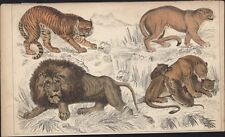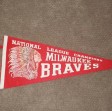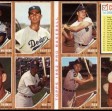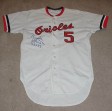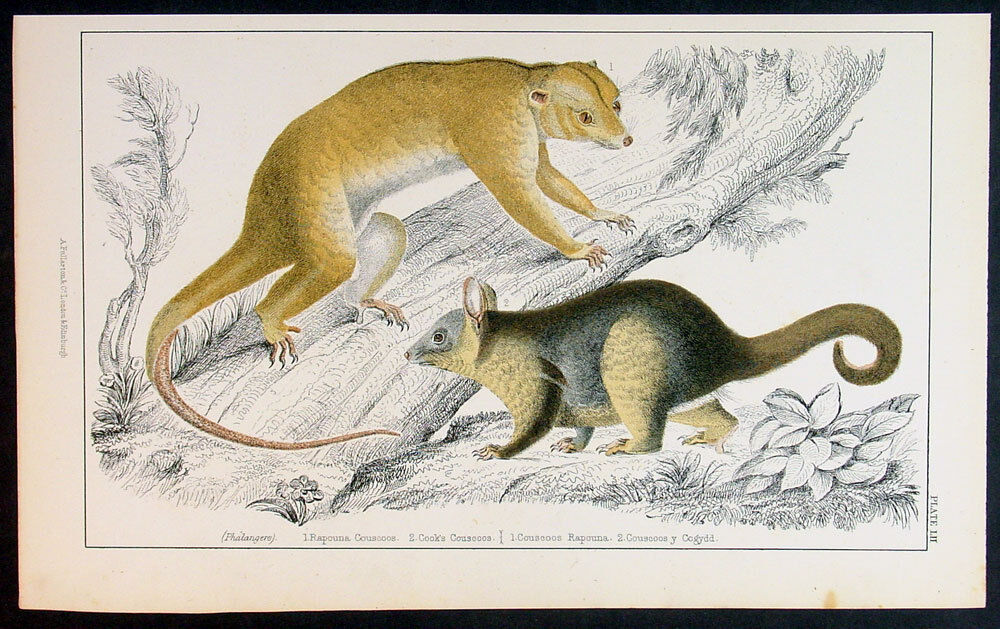
When you click on links to various merchants on this site and make a purchase, this can result in this site earning a commission. Affiliate programs and affiliations include, but are not limited to, the eBay Partner Network.

1830 Goldsmith Antique Print Rapouna & Cooks Couscoos:
$41.79
A History of The Earth and Animated Nature Cartographer : - Goldsmith, Oliver 1728 – 1774 - Date: - 1830
- Size: - 10 1/2in x 6 1/2in (270mm x 165mm)
- Ref#: - 92389
- Condition: - (A+) Fine beautifully hand coloured original antique copper-plated engraved print by Oliver Goldsmith (1728-1774) was published by A. Fullarton & co. in the 1830 edition of Goldsmith's A History of The Earth and Animated Nature
The first edition of A History of The Earth and Animated Nature (in eight volumes) first appeared in London in 1774. The work sought to draw together virtually all that was known about the planet earth, its plants and animals, and even its human inhabitants described from a biological perspective. Goldsmith had intended to translate Pliny's Natural History, but after reading Buffon, he decided that "the best imitation of the ancients was to write from our own feelings and to imitate nature." Goldsmith's Animated Nature went through over twenty editions into the Victorian era and served as a popular source of information about the natural world. (Ref: M&B; Tooley)General Definitions:
Paper thickness and quality: - Heavy and stable
Paper color : - off white
Age of map color: - Original
Colors used: - Yellow, brown, pink, red, blue
General color appearance: - Authentic
Paper size: - 10 1/2in x 6 1/2in (270mm x 165mm)
Plate size: - 10 1/2in x 6 1/2in (270mm x 165mm)
Margins: - Min 1/2in (8mm) Imperfections:
Margins: - Light age toning
Plate area: - None
Verso: - None Background:
Goldsmith, Oliver 1728 – 1774
Goldsmith was an Irish novelist, playwright and poet, who is best known for his novel The Vicar of Wakefield (1766), his pastoral poem The Deserted Village (1770), and his plays The Good-Naturd Man (1768) and She Stoops to Conquer (1771, first performed in 1773). He is thought to have written the classic children\'s tale The History of Little Goody Two-Shoes (1765).
Goldsmiths birth date and year are not known with certainty. According to the Library of Congress authority file, he told a biographer that he was born on 10 November 1728. The location of his birthplace is also uncertain. He was born either in the townland of Pallas, near Ballymahon, County Longford, Ireland, where his father was the Anglican curate of the parish of Forgney, or at the residence of his maternal grandparents, at the Smith Hill House near Elphin in County Roscommon, where his grandfather Oliver Jones was a clergyman and master of the Elphin diocesan school, and where Oliver studied. When Goldsmith was two years old, his father was appointed the rector of the parish of Kilkenny West in County Westmeath. The family moved to the parsonage at Lissoy, between Athlone and Ballymahon, and continued to live there until his father\'s death in 1747.
In 1744 Goldsmith went up to Trinity College, Dublin. His tutor was Theaker Wilder. Neglecting his studies in theology and law, he fell to the bottom of his class. In 1747, along with four other undergraduates, he was expelled for a riot in which they attempted to storm the Marshalsea Prison. He was graduated in 1749 as a Bachelor of Arts, but without the discipline or distinction that might have gained him entry to a profession in the church or the law; his education seemed to have given him mainly a taste for fine clothes, playing cards, singing Irish airs and playing the flute. He lived for a short time with his mother, tried various professions without success, studied medicine desultorily at the University of Edinburgh from 1752 to 1755, and set out on a walking tour of Flanders, France, Switzerland and Northern Italy, living by his wits (busking with his flute).
He settled in London in 1756, where he briefly held various jobs, including an apothecary\'s assistant and an usher of a school. Perennially in debt and addicted to gambling, Goldsmith produced a massive output as a hack writer on Grub Street for the publishers of London, but his few painstaking works earned him the company of Samuel Johnson, with whom he was a founding member of The Club. There, through fellow Club member Edmund Burke, he made the acquaintance of Sir George Savile, who would later arrange a job for him at Thornhill Grammar School. The combination of his literary work and his dissolute lifestyle led Horace Walpole to give him the epithet inspired idiot. During this period he used the pseudonym James Willington (the name of a fellow student at Trinity) to publish his 1758 translation of the autobiography of the Huguenot Jean Marteilhe.
In his Life, Washington Irving states that Goldsmith was between 5’4†and 5’6†in height, not heavily built but quite muscular and with rather plain features. In character he had a lively sense of fun, was totally guileless, and never happier than when in the light-hearted company of children. The money that he sporadically earned was often frittered away or happily given away to the next good cause that presented itself so that any financial security tended to be fleeting and short-lived. Goldsmiths talents were unreservedly recognised by Samuel Johnson whose patronage - somewhat resented by Boswell - aided his eventual recognition in the literary world and the world of drama.
Goldsmith was described by contemporaries as prone to envy, a congenial but impetuous and disorganised personality who once planned to emigrate to America but failed because he missed his ship. At some point around this time he worked at Thornhill Grammar School, later basing Squire Thornhill (in The Vicar of Wakefield) on his benefactor Sir George Savile and certainly spending time with eminent scientist Rev. John Mitchell, whom he probably knew from London. Mitchell sorely missed good company, which Goldsmith naturally provided in spades. Thomas De Quincey wrote of him All the motion of Goldsmith\'s nature moved in the direction of the true, the natural, the sweet, the gentle.
His premature death in 1774 may have been partly due to his own misdiagnosis of his kidney infection. Goldsmith was buried in Temple Church in London. The inscription reads; HERE LIES/OLIVER GOLDSMITH. There is a monument to him in the centre of Ballymahon, also in Westminster Abbey with an epitaph written by Samuel Johnson.
What is an Antique MapThe word Antique in the traditional sense refers to an item that is more than a hundred years old. In the past maps were sold in two forms, as a single sheet (broadsheet) or bound in an atlas or book. The majority of antique maps for sale today come from books or atlases and have survived due to the protection offered by the hardback covers.
When considering a purchase The first thing to determine when staring a collection or purchasing an item, is what is important to you. Most collectors prefer to build their collections around a theme. You may decide to collect maps from one region or country, charting its development through time. Similarly you could collect maps of one particular period in time, by type (i.e. sea or celestial charts) or by cartographer. The collector might also want to consider the theme of cartographical misconceptions such as California as an island or Australia as Terra Australis or the Great Southern Land.
The subject is so wide that any would-be-collector has almost endless possibilities to find his own little niche within the field, and thereby build a rewarding collection.
Starting a collection & pricingPricing is based on a number of different factors, the most important of which is regional. In any series of maps the most valuable are usually the World Map and the America/North America. The World because it is usually the most decorative and America because it has the strongest regional market. Other factors that come into play re: price is rarity, age, size, historical importance, decorative value (colour) and overall condition and quality of paper it is printed on.
As specialised dealers, we frequently work with first time map buyers who are just starting their collection. Guiding new collectors on their first antique map purchase and helping new collectors to focus their interests is one of the most rewarding aspects of being an rare map dealer. So please do not hesitate to contact us and we will be happy to help with any questions you may have.
Payment, Shipping & Return OptionsPlease click on the "Shipping and Payments" Tab above for shipping, payment and return details
About USClassical Images was founded 1998 and has built an excellent reputation for supplying high quality original antiquarian maps, historical atlases, antique books and prints. We carry an extensive inventory of antiquarian collectibles from the 15th to 19th century. Our collection typically includes rare books and decorative antique maps and prints by renowned cartographers, authors and engravers. Specific items not listed may be sourced on request.
Classical Images adheres to the Codes of Ethics outlined by the Antiquarian Booksellers Association of America (ABAA).
We are a primarily an online based enterprise, however our inventory may be viewed by appointment. Please call or email to arrange a viewing.

|



